Abstract
The objective of this study was to evaluate cortisol in the saliva and serum of healthy persons and its daily fluctuations by using immunochemical method on a autoanalyzer. Biological samples: Serum from 14 healthy persons and saliva from 18 healthy persons were taken two times at 8 a.m. and at 4 p.m. Immunochemical assay: The principle of this method is the competitive binding of cortisol present in the analyzed sample and cortisol marked with peroxides on binding parts with specific antibodies. Statistical analysis: Student t-test. Cortisol in saliva in the morning: 21,2 ± 16,2 nmol/l and in the afternoon 12,7 ± 8,1 nmol/l. Cortisol in serum in the morning: 459, 6 ± 235,2 nmol/l, and in the afternoon 340,5 ± 207,5 nmol/l. The concentrations of cortisol in saliva are lower than in serum. Cortisol in the serum in the morning is about twenty times higher than cortisol in the saliva at the same time. Cortisol in the serum at afternoon is about twenty-seven times higher than cortisol in the saliva. Individual variabilities of cortisol in the saliva and serum were found during the day.
Keywords: cortisol, serum, saliva
INTRODUCTION
Cortisol is the main glucocorticoid hormone which is secreted by the cortex of the adrenal gland. According to its chemical structure, cortisol is a steroid hormone. Cortisol affects the metabolism of carbohydrates, fats and proteins. Cortisol is involved in the response to stress and is necessary for the proper functioning of an organism. The adrenal gland cortex secretes the group of different hormones called corticosteroids. According to its leading physiological influence, corticosteroids can be divided into three groups: glucocorticoids (cortisol and corticosteron), mineral corticoids (aldosteron), and androgen hormones (dehydroepiandrosteron and androstenedion). Cortisol, like all other adrenal gland cortex hormones, comes from cholesterol.
Chemistry ofcortisol
From a previous chemical structure and title of cortisol we can see that in basic pregnenolon hydrocarbon, three carbons are replaced by hydroxyl groups in 11, 17, 21 positions and that one -OH group in C-11 atom is in the beta position, while the other -OH group in C-17 atom is in the alpha position. Between C-4 and C-5 is a double connection (4-en) and in atoms C-3 and C-20 are two keton groups.
Cortisol in different bodyfluids
Cortisol is measured in blood and urine, and recently, especially in situations when the sample of blood is hard to take, cortisol is measured in saliva as well. By determining the concentration of cortisol in serum or plasma, intensity of secretion and its effect on tissue is defined. In this determination it is necessary to know that analysis of one sample of serum or plasma shows concentrations at certain moments. By determining the concentration of cortisol in 24- hours urine volume, the amount of cortisol secreted during the day is defined, by which the function of the cortex of adrenal gland can be shown. Saliva is used as an alternative sample for the measurement of cortisol in the last decade. Referential values of cortisol concentration are classfied according to the time when the sample is taken. The referential areas are affected by several factors which can vary, so it is recomended that every laboratory should define its own referential values. Referential values of cortisol in certain body fluids, determined in Laboratory of Clinical Biochemistry of Institute for Clinical Biochemistry and Chemistry of Clinical Centre at University of Sarajevo, are: In serum
In the morning (8 - 9 a.m.) 123,0 - 626,0 nmol/l
Afternoon (4 - 5 p.m.) 46,2 - 389,0 nmol/l
In saliva
In the morning (8 - 9 a.m) 3,5 - 27,0 nmol/l
Afternoon (4 - 5 p.m.) 1,3 - 6,0 nmol/l
In urine
59,2 do 413,0 nmol /24
MATERIALS AND METHOD
Biological materials
Biological material serum of blood and saliva is used in these analyses. Blood from veins is taken from 14 healthy persons, 8 man and 6 women, two times in the morning (8 - 9 a.m.) and after noon (4 - 5 p.m.). After the coagulation samples are centrifugated (five minutes, 4000 turns), in order to put aside serum in which measures of cortisol concentration are done. Samples of saliva are taken from 18 healthy persons, 10 men and 8 women, two times, in the morning (8 - 9 a.m) and after noon (4 - 5 p.m.). Samples of saliva are centrifugated as well, in order to get fluid without additions. Samples of serum and saliva were held at temperature -24°C degrees.
Determination ofcortisol with immunochemical method
Evaluation of cortisol concentration in serum and saliva is done on an autoanalyzer, by the Immunochemical method, which is based on immunochemical reaction with luminescence. Determination is based on competitive binding of cortisol in sample and cortisol marked with peroxidase, on binding places with special antybodies(sheep anty-cortisol). Antigen -antibody complexes which are formed are caught with streptavidine at barriers of vessel; materials that are not bound are taken out with washing. The activity of bound peroxidase is measured by luminiscent reaction. Bound peroxidase catalyses oxidation of luminol derivatives forming the light. Light signals are shown on the machine. The amount of bound peroxidase is reversely proportional to the concentration of present cortisol. Statistical analysis of the results is done by Student t-test.
RESULTS
Concentration ofcortisol in saliva
The results of measuring the concentration of cortisol in saliva before and after noon shown in Table 1, and results from the Graph 1, show that there are daily fluctuations of cortisol concentrations in saliva. Results show that concentration of cortisol in saliva is statistically much higher in the morning, than it is in the after noon (p<0,01).
TABLE 1.
Concentration of Cortisol in saliva of healthy persons in the morning and afternoon
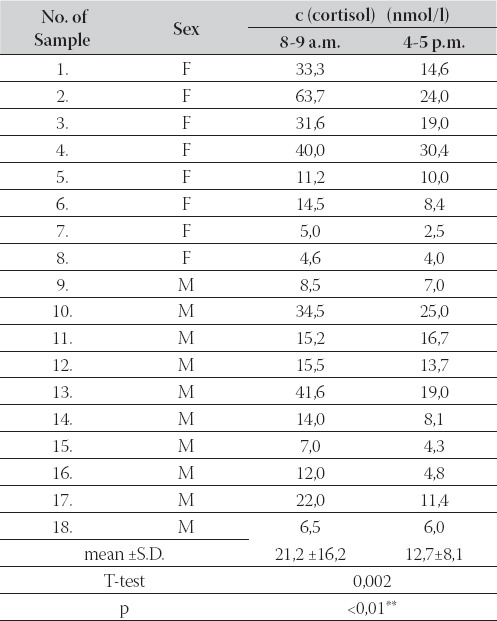
GRAPH 1.
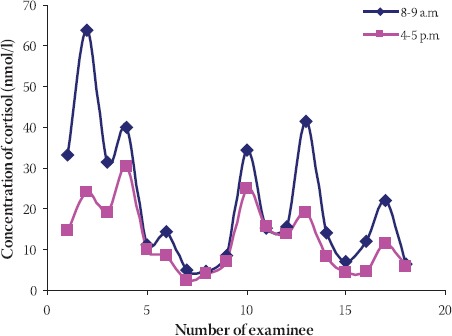
Concentration of Cortisol in saliva of healthy persons in the morning and afternoon
Concentration ofcortisol in saliva ofhealthy persons, in the morning and afternoon, according to the sex of examinee
Results show that there are daily fluctuations of cortisol in the saliva of men and women as well. The concentration of cortisol is statistically much higher in the morning than it is in the afternoon in the saliva ofboth sexes. Regarding the persons of female sex, the higher middle value of cortisol concentration in saliva is found in comparison with male persons, in the morning and afternoon. The differences between genders are not statistically important (Tables 2 and 3).
TABLE 2.
Concentration of cortisol in saliva of female persons in the morning and afternoon
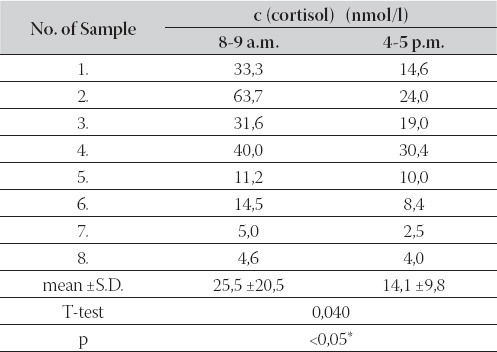
TABLE 3.
Concentration of cortisol in saliva of male examinees in the morning and afternoon
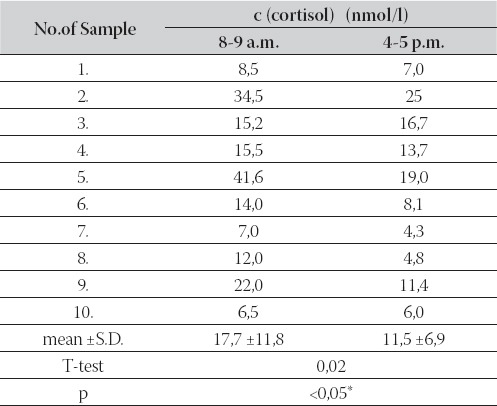
Concentration ofcortisol in serum
The results of measurements of cortisol concentration in serum in the morning and afternoon shown in Table 4, as well as in the Graph 2, show that there are daily fluctuations of cortisol concentration in serum. Results have shown that concentration of cortisol in serum is statistically much higher in the morning than it is in the afternoon (p<0,001).
TABLE 4.
Concentration of cortisol in serum of healthy persons in the morning and afternoon
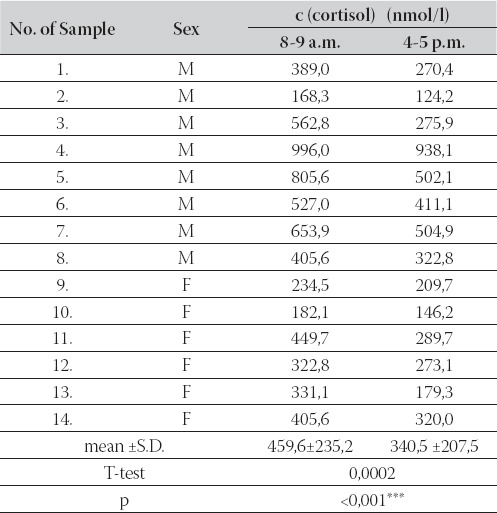
GRAPH 2.

Concentration of Cortisol in serum of 14 healthy persons in the morning and afternoon
Concentration ofcortisol in serum ofhealthy persons before and after noon according to the sex ofexaminee
Cortisol concentration measurements in serum show that there are daily fluctuations of cortisol concentration in the serum of both sexes. Concentration of cortisol in serum is statistically much higher in the morning than it is in the afternoon, in the serum of both sexes. Regarding the female examinees, the lower middle value of cortisol concentration is found, in comparison with the male examinees, in the morning and afternoon as well. The differences between persons of different sex are not statistically important. (Table 5 and 6).
TABLE 5.
Concentration of cortisol in serum of female examinees in the morning and afternoon
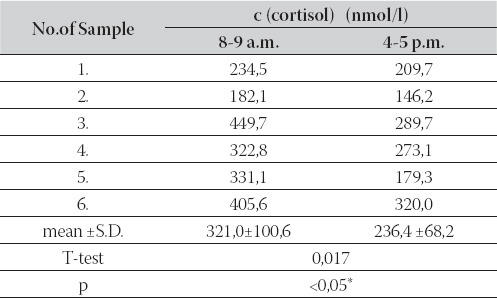
TABLE 6.
Concentration of cortisol in serum of male persons in the morning and afternoon
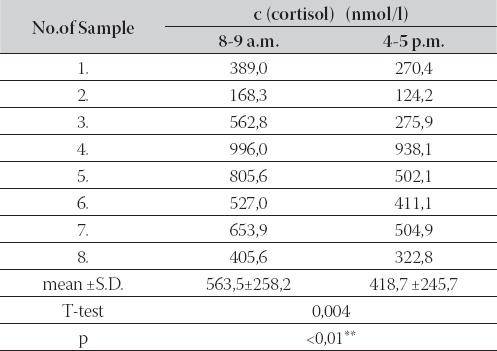
Comparison ofcortisol concentration in saliva and serum
According to the data shown in Table 7, which are shown in Graph 3, it can be seen that the middle value of cortisol concentration, in the morning, in serum is 22 times higher than the middle value of cortisol concentration in saliva, and the middle value of cortisol concentration in serum, afternoon, is 27 times higher than the middle value of cortisol concentration in saliva.
TABLE 7.
Middle values and standard deviations of cortisol concentration in serum and saliva in the morning and afternoon

GRAPH 3.
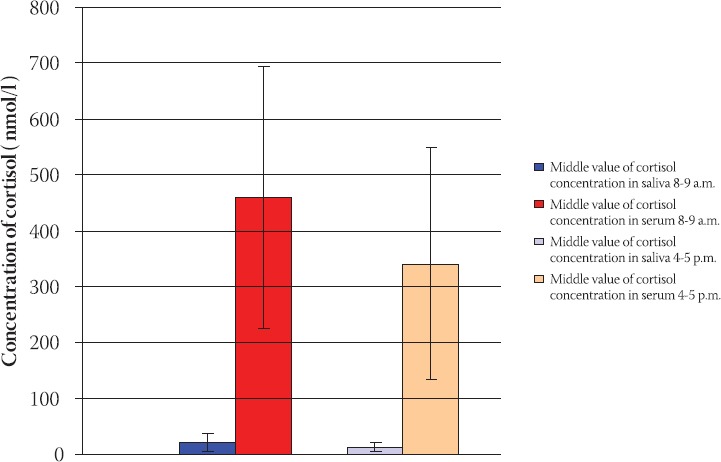
Comparison of Cortisol concentration in saliva and serum in the morning and afternoon
DISCUSSION
Cortisol is the main glucocorticoid hormone which is secreted by the cortex of the adrenal gland and the most important one. Synthesis and secretion of cortisol are controlled by adenohypophysis hormone, adrenocorticotropin hormone, ACTH, while the synthesis and secretion of ACTH is controlled by hypothalamus hormone, corticotrophin releasing hormone, CRH. The highest amount of cortisol is bound with corticosteroid connecting globulin CBG (corticosteroid - binding globulin) or transcortin, while the rest is bound with albumins of plasma. Production of cortisol has an independent circadian daily rhythm with the highest concentration in early morning hours and the lowest concentration in the evening (1). The factor which controls this rhythm is not defined and it can be affected by physical and psychological conditions. ACTH and cortisol can be secreted independently of circadian rhythm as a reaction to physical and psychological stress (2). Higher concentration of cortisol and lack of daily rhythm can be identified as Cushing’s Disease. As well as in patients with adrenal tumors, low cortisol concentration can be found at primary insufiation of adrenal core gland (Addison’s disease) and lack of ACTH (3). The results of our measurements have shown the lower value of cortisol concentration in the afternoon hours in comparison to the measurements in the morning in samples of saliva (Table 1 and Graph 1), as well as in samples of saliva (Table 4 and Graph 2). Besides the measurements of blood in urine, the measured of cortisol concentration in saliva has recently become the important choice in many analyses. Taking the samples of saliva has many practical advantages, because cortisol in saliva can be measured under many clinical and practical conditions. It is believed that cortisol enters the saliva by passive diffusion or in the other ways independent of active mechanism transports, the concentration of cortisol in saliva remains unchanged depending on the amount of saliva that is formed. According to the concept of free hormone (4, 5) only unbound cortisol comes to the target tissue and forms the reaction of glucocortoidal effects. Recently, many scientists and endocrinologists have examined new methods and applications of cortisol concentration measurement of cortisol in order to have additional proofs of the importance of cortisol measurings in saliva. This will encourage wider cortisol measurings in basic and clinical psychoendocrinological examinations. Despite the fact that many researchers have shown that there is a correlation between the concentration of the cortisol in saliva and the concentration of cortisol in plasma and serum, certain doubts still exist. The results that support this theory are shown in the body fluids of healthy persons. High correlations between saliva and serum cortisol are noticed in newborns (6), childern and adolescents (7), elders (8), as well as psychiatric patients (9). Simultaneous cortisol measurement in blood and saliva of volunteers to whom have been given exogenous cortisol and deksametason have shown important correlations (9, 10, 11). Most studies show that the amount of saliva cortisol is connected with the amount of cortisol in blood, but the absolute cortisol concentration that is found in saliva is much lower than the cortisol concentration in blood in all studies. Results of our measurement have shown a lower cortisol concentration in samples of saliva in comparison to concentrations of cortisol in samples of serum, as well as in samples that were taken before noon and afternoon hours (Table 7. and Graph 3). It could be concluded that measurements of saliva cortisol in early morning hours could completely replace of measurements of cortisol in serum and plasma.
FIGURE 1.
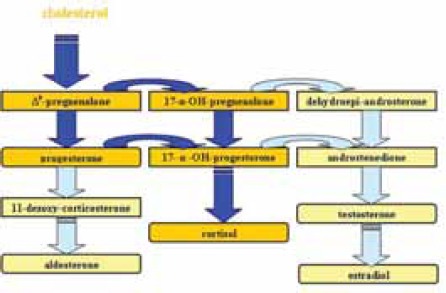
Cholesterol as predecessor of steroid hormons
FIGURE 2.
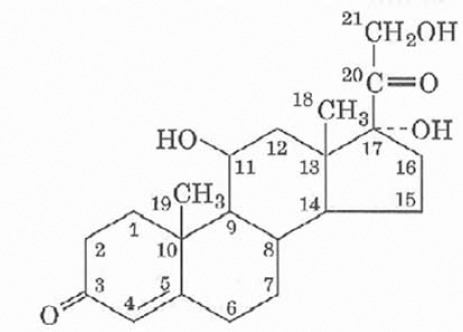
11 p, 17a, 21 - trihydroxypregnan - 4 - en - 3,20 -dion (Cortisol)
CONCLUSION
There are very complicated daily fluctuations of cortisol in the saliva of healthy persons of both sexes, because the middle value of cortisol concentration before noon is statistically significantly higher in comparison to the middle value of cortisol concentration in the after noon.
Higher Cortisol concentration in saliva of female is found in comparison to the male examinees, but these differences are not statistically important.
There are very complicated daily fluctuations of cortisol in serum of healthy persons of both sexes, because the middle value of cortisol concentration before noon is statistically significantly higher than the middle value of cortisol concentration after noon.
Cortisol concentration in serum of females is lower in comparison with male examinees, but these differences are not statisticaly important.
Middle value of cortisol concentration, in serum is much higher than it is in saliva. It is 22 times higher before noon, and 27 times higher in the after noon.
Individual variability of cortisol concentration is evident during the day both in serum and saliva.
The concentrations of cortisol in saliva are very low, so it is recommended that in cases of metabolical disorders, sampling time of saliva should be taken in consideration.
Measurements of saliva cortisol, especially in early morning hours can completely substitute for measurements of cortisol in serum or plasma.
REFERENCES
- 1.Kreiger D.T. Rhythms of ACTH and corticopsteroid secretion in health and disease and their experimental modification. J. Steroid. Biochem. 1975;6:785–791. doi: 10.1016/0022-4731(75)90068-0. [DOI] [PubMed] [Google Scholar]
- 2.Nicholson N, Storms C, Ponds R, Sulon J. Salivary cortisol levels and stress reactivity in human aging. J. Gerontol. 1997;52:6875. doi: 10.1093/gerona/52a.2.m68. [DOI] [PubMed] [Google Scholar]
- 3.Migeon C.J, Lanes R.L. Adrenal cortex : hypo-and hyperfunction. In: Lifshitz F, editor. Pediatric Endocrinology. A Clinical Guide. 2nd edition. NY: Marcel Dekker Inc; 1990. pp. 333–352. [Google Scholar]
- 4.Mendel C.M. The free hormone hypothesis: A physologically based mathematical model. Endocr. Rev. 1989;10:232–274. doi: 10.1210/edrv-10-3-232. [DOI] [PubMed] [Google Scholar]
- 5.Robbins J, Rall J.E. The interaction of the thyroid hormones and protein in biological fluids. Recent. Prog. Horm. Res. 1957;13:161–208. [PubMed] [Google Scholar]
- 6.Gunnar M.R, Conors J, Isensee J. Lack of stability in neonatal adrenocortical reactivity because of rapid habituation of the adrenocortical response. Dev. Psychobiol. 1989;22(3):221–233. doi: 10.1002/dev.420220304. [DOI] [PubMed] [Google Scholar]
- 7.Koraćević D, Bjelaković G, Đorđević V, Nikolić J, Pavlović D, Kocić G. Biochemistry of hormones Saliva Biochemistry. Contemporary administration Beograd. 2003;706-815:1040–1044. [Google Scholar]
- 8.Reid J.D, Intrieri R.C, Susman E.J, Beard J.L. The Relationship of serum and salivary cortisol in a sample of healthy elderly. J. Gerontol. 1992;47:176–179. doi: 10.1093/geronj/47.3.p176. [DOI] [PubMed] [Google Scholar]
- 9.Harris B, Watkins S, Cook N, Walker R.F, Read G.F, Riad-Fahmy D. Comparisons of plasma and salivary cortisol determinations for the diagnostics efficacy of the dexamethasone suppression test. Biol. Psychiatry. 1990;27:897–904. doi: 10.1016/0006-3223(90)90471-d. [DOI] [PubMed] [Google Scholar]
- 10.McCracken J.T, Poland R.E. Saliva and serum cortisol dynamics following intravenous dexamethasone in normal volunteers. Life. Sci. 1989;45:1781–1785. doi: 10.1016/0024-3205(89)90517-1. [DOI] [PubMed] [Google Scholar]
- 11.Woodside D.B, Winter K, Fisman S. Salivary cortisol in children: Correlations with serum values and effect of psychotropic drug administration 1991. Can. J. Psychiatry. 1991;36(10):746–748. doi: 10.1177/070674379103601011. [DOI] [PubMed] [Google Scholar]


